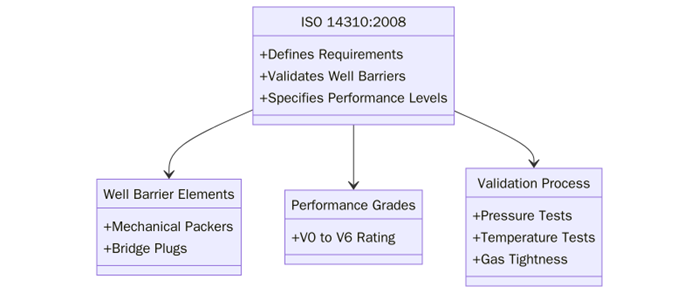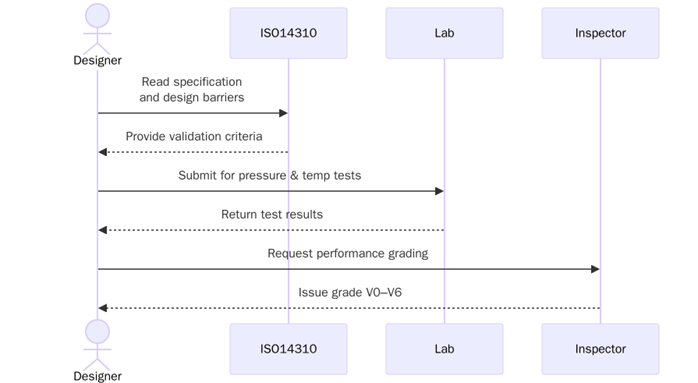What is ISO 14310?

ISO 14310:2008 is an international standard that specifies the requirements for packers and bridge plugs used in downhole equipment in the petroleum and natural gas industries. These components are critical for well construction, well intervention and production operations, as they help isolate sections of the well, providing pressure control and ensuring the safety and integrity of the wellbore during drilling, completion and production activities.
ISO 14310:2008 provides guidelines for the design, materials, manufacturing, testing and performance of packers and bridge plugs to ensure that they can withstand the harsh conditions often encountered in downhole environments, such as high temperatures, pressure and corrosive fluids.
For more information, contact us at support@pacificcert.com.
Purpose
The purpose of ISO 14310 is to establish a standard for the design, testing and use of packers and bridge plugs to ensure their reliability and performance in petroleum and natural gas wells. These tools play a vital role in isolating sections of the wellbore, preventing fluid migration and controlling pressure during drilling, completion and production.

By adhering, organizations ensure that these components meet the necessary safety, quality and operational requirements, reducing the risk of failure and improving well integrity.
Scope and Applicability
ISO 14310:2008 applies to all organizations involved in the design, manufacturing and use of packers and bridge plugs in the petroleum and natural gas industries. The standard is relevant to well completion, intervention and production operations where well integrity and pressure control are crucial. It provides manufacturers and service providers with the necessary guidelines for ensuring that these components meet the required standards for quality, safety and performance.
ISO 14310 is applicable to various types of packers and bridge plugs, including mechanical and inflatable packers, as well as those used in different wellbore environments such as high-pressure, high-temperature and corrosive conditions.
Key Definitions
- Packers: Devices used to seal off sections of a wellbore, isolating one section of the well from another. They are critical for maintaining pressure control and preventing fluid migration.
- Bridge Plugs: A type of plug used to isolate sections of a wellbore, typically used during well intervention or abandonment.
- Downhole Equipment: Tools and components used in the construction, maintenance and operation of wells in the petroleum and natural gas industries.
- Inflatable Packer: A packer that uses pressure to inflate and form a seal against the wellbore wall.
- Mechanical Packer: A packer that uses mechanical means (such as slips or cones) to create a seal in the wellbore.
Clause-wise structure of ISO 14310
Clause Number | Title |
| Description |
Clause 1 | Scope | Defines the scope of the standard and specifies the types of packers and bridge plugs covered. | |
Clause 2 | Normative References | Lists the referenced documents and standards that support the requirements of ISO 14310:2008. | |
Clause 3 | Terms and Definitions | Provides key terms and definitions to ensure clarity and consistency in the standard. | |
Clause 4 | General Requirements | Outlines the general requirements for packers and bridge plugs, including performance, design and material specifications. | |
Clause 5 | Material Requirements | Specifies the material properties required for packers and bridge plugs to ensure durability and performance under downhole conditions. | |
Clause 6 | Manufacturing Process | Describes the manufacturing methods, quality control and inspection processes required for producing these components. | |
Clause 7 | Performance Testing | Outlines the performance tests required to verify that packers and bridge plugs can withstand expected downhole conditions. | |
Clause 8 | Packaging and Marking | Specifies packaging, labelling and marking requirements for packers and bridge plugs to ensure proper identification and traceability. | |
Clause 9 | Compliance and Certification | Details the process for certifying compliance with ISO 14310 and the standards for packers and bridge plugs. |
What are the requirements of ISO 14310?
ISO 14310 ensures that packers and bridge plugs meet the necessary standards for quality, safety and operational performance. The following requirements ensure that these components can withstand the demanding conditions encountered in downhole environments. Below are the key requirements:

- Packers and bridge plugs must be constructed from materials that are durable, resistant to corrosion and capable of withstanding high pressure and temperature conditions.
- The design must ensure a reliable seal under all operating conditions, including the ability to maintain pressure control and prevent fluid migration.
- Packagers and bridge plugs must undergo rigorous testing, including pressure tests, thermal cycling and mechanical strength tests, to ensure they perform effectively under downhole conditions.
- The components must be compatible with other downhole equipment, ensuring proper installation and functionality.
- Manufacturers must certify that their products meet the requirements outlined in the standard through quality control processes and third-party certification.
For more information, contact us at support@pacificcert.com.
What are the benefits of ISO 14310 Certification?
ISO 14310 certification provides organizations with a standardized approach to ensure the safety, quality and reliability of their downhole components. By meeting the requirements of the standard, organizations can improve product quality, reduce risks and upgrades their reputation. Below are some of the key benefits of obtaining ISO 14310 certification:

- Certification ensures that packers and bridge plugs meet high-quality standards, improving reliability in downhole applications.
- Certification minimizes the risk of operational failures, improving the safety of well construction and maintenance.
- Achieving certification helps organizations meet industry regulations and standards related to downhole equipment.
- Certification upgrades the reputation of manufacturers and suppliers, demonstrating a commitment to quality and safety.
As the demand for oil and gas continues to grow and well construction becomes more complex, the need for reliable downhole equipment, including packers and bridge plugs, will increase. In the recent years, the oil and gas industry will continue to prioritize compliance with international standards like ISO 14310 to ensure safety, operational efficiency and regulatory compliance. ISO certified products will be essential for meeting industry demands, offering a competitive advantage in a rapidly evolving market.
Certification Process
The certification process for ISO 14310 typically includes the following steps:
- Pre-Certification Assessment: Conducting a gap analysis to identify areas for improvement in the manufacturing and testing processes.
- Documentation Review: Reviewing existing documentation to ensure compliance with ISO 14310 for packers and bridge plugs.
- Stage 1 Audit: A preliminary audit to assess the organization’s readiness for certification and verify compliance with the standard.
- Stage 2 Audit: A overreaching on-site audit to evaluate the implementation of processes, manufacturing and testing protocols.
- Certification Decision: Certification is awarded once all requirements are met and the organization demonstrates compliance with ISO 14310.
- Ongoing Monitoring: Regular audits and recertification ensure continued compliance with the standard.
Timeline for ISO 14310 Certification
The timeline for ISO 14310 certification spans several months. The pre-assessment and preparation phase generally takes 1-2 months, during which the organization reviews its current processes and prepares for audits. The Stage 1 audit usually lasts about 1 month. The Stage 2 audit, involving a overreaching evaluation of the manufacturing processes, takes around 1-2 months. Certification issuance occurs within 3-6 months, depending on the audit findings and the organization’s readiness for certification.
What is the Cost?
The cost of ISO 14310 certification depends on factors such as the size of the organization, the complexity of its operations and the number of components manufactured. Typical costs include:
Audit fees is the fees for the certification body’s audit process. Training costs is the cost for educating staff on ISO 14310 and the necessary processes to comply with the standard. Ongoing maintenance is the cost for regular audits, recertification and maintaining compliance every 3 years.
How Pacific Certifications Can Help?
At Pacific Certifications, we provide overreaching auditing and certification services for ISO 14310. Our team will guide you through the entire certification process, ensuring that your organization complies with the highest standards for lock mandrels and landing nipples. Our services include:
- Stage 1 and Stage 2 audits to evaluate the manufacturing and testing processes.
- Objective conformity assessments based on ISO 14310.
- Certification issuance upon successful completion of the audit.
- Ongoing surveillance audits to ensure continued compliance.
- Support for multi-site or global operations.
For audits and certification, contact support@pacificcert.com.
Training and Courses
Various training courses are available to help organizations comply with ISO, including:
- Lead Auditor Training – Equips professionals to conduct external third-party audits.
- Lead Implementer Training – For those responsible for planning and executing ISO 14310 implementation.
- Internal Auditor Training – Preparing internal auditors for certification audits
Pacific Certifications provides accredited training programs. If your organization is looking for ISO training, our team is equipped to help you. Contact us at support@pacificcert.com.
Frequently Asked Questions (FAQs)
How long does it take to get ISO 14310 certification?
The certification process takes 3–6 months, depending on your organization’s preparedness and audit outcomes.
Is ISO 14310 certification mandatory for all packer and bridge plug manufacturers?
While it is not legally required, ISO 14310 certification is essential for ensuring the safety, quality and reliability of downhole components.
What are the main benefits of ISO 14310 certification?
Certification ensures compliance with international standards, improves product reliability, upgradess operational safety and boosts customer confidence.
Can I apply for ISO 14310 certification without a quality management system in place?
No, a quality management system is necessary before applying for certification to ensure compliance with ISO 14310.
How often do I need to renew ISO 14310 certification?
ISO 14310 certification is valid for three years, after which recertification is required.
Ready to get ISO 14310 certified?
Contact Pacific Certifications to begin your certification journey today!
Suggested Certifications –
Read more: Pacific Blogs








